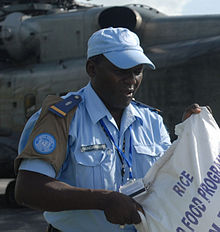- Brassard
-
For other uses, see Brassard (disambiguation).For non-military uses, see Armband."Armlet" redirects here. For the jewelry, see arm ring.
A brassard or armlet (British English) is an armband or piece of cloth or other material worn around the upper arm, used as an item of military uniform to which rank badges (or other insignia) may be attached instead of being stitched into the actual clothing. The brassard, when spread out, may be roughly rectangular in shape, where it is worn merely around the arm; it may also be a roughly triangular shape, in which case the brassard is also attached to a shoulder strap.
Brassards are also used with the uniforms of organizations which are not military but which are influenced by and styled upon the military, such as police, emergency services, volunteer services, or militaristic societies and political parties.
A brassard is often used:
- to temporarily attach insignia, such as rank, to clothing not normally bearing insignia (such as civilian clothing or a military mechanic's coveralls);
- to temporarily attach insignia to a uniform for a limited time, such as the insignia for an "officer of the day" or "duty officer"; or for uniforms expected to have a high turnover of either wearer or insignia borne, such as those of cadets or other youth organizations. Brassards worn by military police and Red Cross personnel fall under this category.
Brassard (also "brassart" or "brasset") is also used to refer to pieces of armour worn to cover the entire arm (encompassing vambrace, rerebrace, and possibly a couter).References
- Rosignoli, Guido (1986). The Illustrated Encyclopedia of Military Insignia of the 20th Century. New Jersey: Chartwell Books Inc. p. 69. ISBN 1-55521-085-6.
Categories:- Military insignia
- Military uniforms
- Personal armour
Wikimedia Foundation. 2010.

